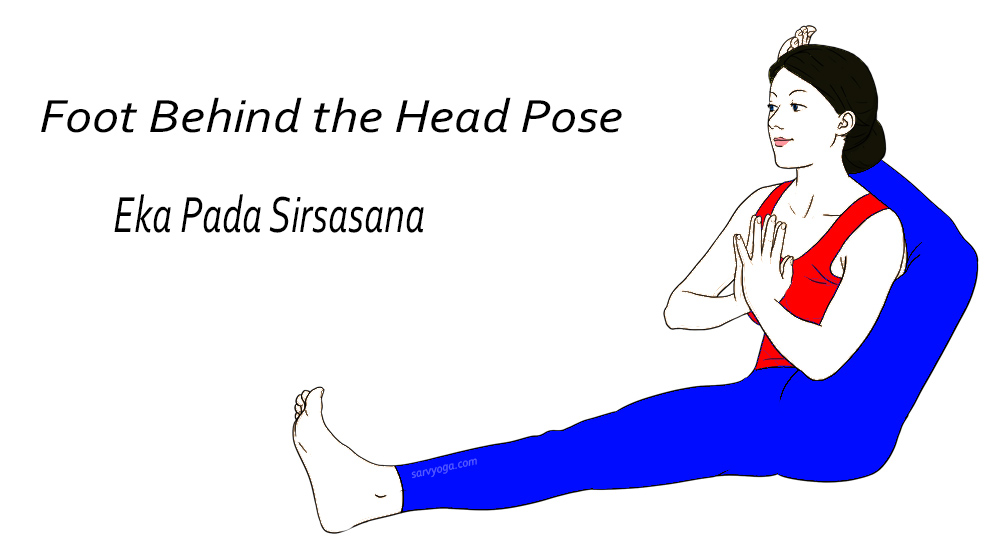Eka Pada Sirsasana (Foot Behind the Head Pose) is the best for advanced level practitioners. But it demands the combination of strength and flexibility. So, that’s why it comes at the advanced level. Note that, it is not for beginners; Eka Pada Sirsasana is totally hardcore hip –opener as well as directly targets your hamstrings.
Beginner’s who are looking forward to Eka Pada Sirsasana first brushing up your basics. Because it’s not easy to perform Asana, it’s better if you practice a lot other hip opener and hamstrings related Asana. Apart from physical demands, it needs your patience. Not to worry if you can’t get your leg behind your head in the first attempt. Day by day you feel the improvement but one thing doesn’t go beyond over your capabilities.
Asana Name – Foot behind the head Pose
Sanskrit Name – Eka Pada Sirsasana
Asana Level – Intermediate
Focusing Chakra –
- The third eye chakra (Ajna)
- The root chakra (Muladhara)
Navigator
Meaning
- Eka – One
- Pada – Foot or leg
- Sirsasana- Headstand pose
Eka Pada Sirsasana (Foot Behind the Head Pose) Steps
- Sit comfortably in the Staff Pose (Dandasana) with legs stretched straight.
- After that, slightly twist (bend) your right Knee. Now keep the sole of your right foot to the floor with your left knee.
- Next step, lower your right knee to the right side of the floor. Now open your hip.
- The movement or rotation of the hip is the important thing for setting up the final position.
- After that, hold/grab your ankle of your right foot. Embrace (hug) your right shin towards your chest.
- But you’ve to keep your ankle parallel to your other ankle.
- What you have to do, just grab your right ankle with by your left hand.
- Now it is the important part, slowly – slowly lift as well as draw your right knee towards the shoulder. You have to fit your right ankle behind the neck and left shoulder.
- Your leg touches the neck region, for maintaining the position you may lean forward for few seconds.
- But keep your other leg straight in front of you. Note that your sit bones are strongly placed. Move your right shoulder in a forward direction and your right leg moves backward on the top of shoulder.
- When you feel your right foot is completely tucked behind the neck. Then take your both hands towards the chest and make prayer pose (Namaste gesture). But your hands should touch your chest.
- Now you’re in the final Position, remain in the pose for five to six breaths.
- Lower down your hands and with the left hand grab the right toe. Unfold your right leg and lower down your right leg.
- Follow the same procedure with your other leg also.
Benefits of Eka Pada Sirsasana (Foot Behind the Head Pose)
- Eka Pada Sirsasana is an awesome hip opener exercise.
- Foot behind the head pose (Eka Pada Sirsasana) lower down your fatigue & stress level.
- Apart from hip opening Eka Pada Sirsasana strengthens & stretches your calves, spinal cord, hamstrings, and hip flexors also.
- The hip opening means you got flexible sitting bones.
Tips for Practitioner’s
- As you know that, Eka Pada Sirsasana is an intensive Asana. So, perform counter Asana just after the Practice of Eka Pada Sirsasana.
- You may follow Wheel pose, Ustrasana, Setu Bandha Asana.
- If you feel unbearable pain or strain then stops the Asana.
- Counter Poses rejuvenates and release the stress which you got from Eka Pada Sirsasana.
- Remember one thing don’t challenge your physical limits.
Important Notes
- Throughout the process breathe deeply.
- If you’re a new face to Yoga then avoid Foot Behind the Head Pose.
- Daily practitioner’s of Yoga, when attempting this first time please take the help of partner/trainer.
- In case of hip, knee, neck or back injuries strictly avoid Eka Pada Sirsasana.
- It’s better if you perform some hip opener Asana before performing this Asana.
- With tight hamstrings also avoid Eka Pada Sirsasana.
- Do not attempt if you have a knee, ankle, back or neck injury.
- Its mandate to follow the instruction carefully. And perform your posture in a correct way.
- For this, you need a well-certified trainer or teacher. So, don’t become a teacher yourself.
(Beauty with a brain is an awesome combo)

